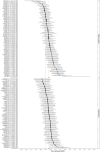Evidence for Infant-directed Speech Preference Is Consistent Across Large-scale, Multi-site Replication and Meta-analysis
- PMID: 38665547
- PMCID: PMC11045035
- DOI: 10.1162/opmi_a_00134
Evidence for Infant-directed Speech Preference Is Consistent Across Large-scale, Multi-site Replication and Meta-analysis
Abstract
There is substantial evidence that infants prefer infant-directed speech (IDS) to adult-directed speech (ADS). The strongest evidence for this claim has come from two large-scale investigations: i) a community-augmented meta-analysis of published behavioral studies and ii) a large-scale multi-lab replication study. In this paper, we aim to improve our understanding of the IDS preference and its boundary conditions by combining and comparing these two data sources across key population and design characteristics of the underlying studies. Our analyses reveal that both the meta-analysis and multi-lab replication show moderate effect sizes (d ≈ 0.35 for each estimate) and that both of these effects persist when relevant study-level moderators are added to the models (i.e., experimental methods, infant ages, and native languages). However, while the overall effect size estimates were similar, the two sources diverged in the effects of key moderators: both infant age and experimental method predicted IDS preference in the multi-lab replication study, but showed no effect in the meta-analysis. These results demonstrate that the IDS preference generalizes across a variety of experimental conditions and sampling characteristics, while simultaneously identifying key differences in the empirical picture offered by each source individually and pinpointing areas where substantial uncertainty remains about the influence of theoretically central moderators on IDS preference. Overall, our results show how meta-analyses and multi-lab replications can be used in tandem to understand the robustness and generalizability of developmental phenomena.
Keywords: infant-directed speech; looking time preference; mega-analysis; meta-analysis; multi-lab replication.
© 2024 Massachusetts Institute of Technology.
Conflict of interest statement
Competing Interests: The authors declare no conflict of interests.
Figures



References
-
- Anderson, L., Hwang, H., Kamhout, S., Giliat, S., Lundwall, R. A., Black, A., Kartushina, N., Kosie, J., Tsui, A., Zettersten, M., Bergmann, C., & The ManyBabies Consortium (2021). A fresh look at infant-directed speech preference through an updated meta-analysis. Poster presented at the Biennial Meeting of the Society for Research in Child Development.
-
- Bates, D., & Maechler, M. (2021). Matrix: Sparse and dense matrix classes and methods [Computer software manual]. Retrieved from https://CRAN.R-project.org/package=Matrix (R package version 1.3-2).
-
- Bergmann, C., Tsuji, S., Piccinini, P. E., Lewis, M. L., Braginsky, M., Frank, M. C., & Cristia, A. (2018). Promoting replicability in developmental research through meta-analyses: Insights from language acquisition research. Child Development, 89(6), 1996–2009. 10.1111/cdev.13079, - DOI - PMC - PubMed
-
- Braginsky, M., Mathur, M., & VanderWeele, T. J. (2023). PublicationBias: Sensitivity analysis for publication bias in meta-analyses [Computer software manual]. Retrieved from https://CRAN.R-project.org/package=PublicationBias (R package version 2.4.0). - PMC - PubMed
-
- Byers-Heinlein, K., Tsui, A. S. M., Bergmann, C., Black, A. K., Brown, A., Carbajal, M. J., Durrant, S., Fennell, C. T., Fiévet, A.-C., Frank, M. C., Gampe, A., Gervain, J., Gonzales-Gomez, N., Hamlin, J. K., Havron, N., Hernik, M., Kerr, S., Killam, H., Klassen, K., … Wermelinger, S. (2021). A multi-lab study of bilingual infants: Exploring the preference for infant-directed speech. Advances in Methods and Practices in Psychological Science, 4(1). 10.1177/2515245920974622, - DOI - PMC - PubMed
Grants and funding
LinkOut - more resources
Full Text Sources
Miscellaneous
